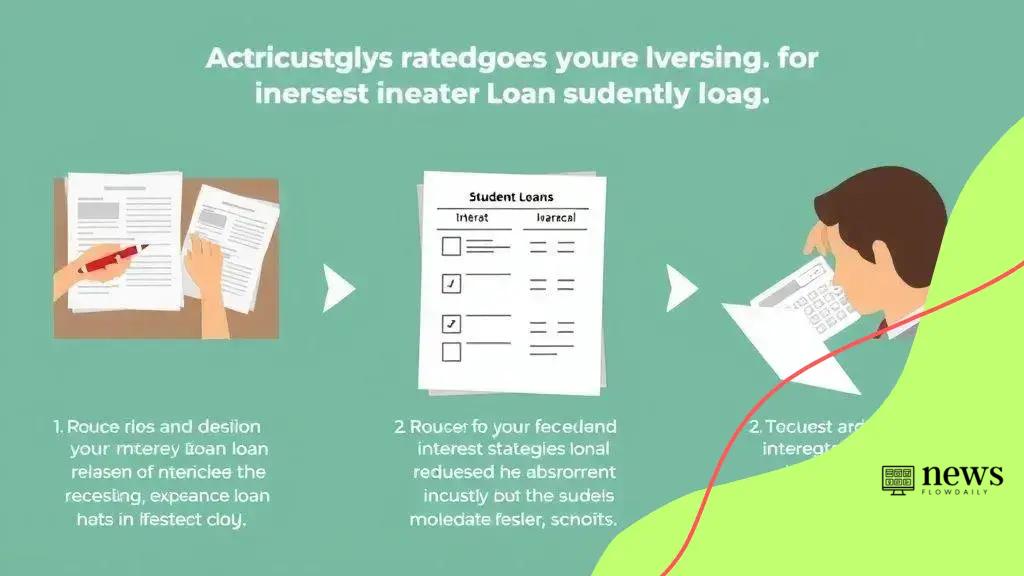Navigating student loans involves understanding loan types, evaluating repayment options, utilizing budget strategies, and accessing resources that provide support to help manage debt effectively.
Navigating student loans can feel overwhelming, but it doesn’t have to be. With the right strategies, you can manage your debt more effectively and regain control of your finances. What if you could lighten your financial load with a few simple adjustments?
Understanding the types of student loans
Understanding the types of student loans is crucial for making informed decisions about your education financing. Loans can differ in terms of their source, terms, and repayment options.
Federal Student Loans
Federal student loans are provided by the government and often have lower interest rates than private loans. They also come with benefits that can help borrowers manage their repayments.
- Direct Subsidized Loans: The government pays the interest while you’re in school.
- Direct Unsubsidized Loans: Interest accrues while you’re in school, but you can choose to pay it later.
- Direct PLUS Loans: These loans are available for graduate students and parents, helping cover any remaining education costs.
Private student loans come from banks and financial institutions. They can be useful when federal loans fall short, but they often come with less favorable terms. Understanding these differences can better prepare you for your borrowing journey.
Characteristics of Private Loans
Unlike federal loans, private loans generally require a credit check. This means your credit score can influence the interest rate and terms of the loan. It’s crucial to compare offers from different lenders to find the best deal.
- Variable or Fixed Rates: Some loans have variable rates, while others are fixed. Knowing which option works for you is key.
- Co-signers: If you have limited credit history, having a co-signer may help you secure a loan.
- Repayment Terms: Terms can vary widely, so look for lenders that offer flexible repayment options.
In addition to federal and private loans, there are also state-sponsored programs and scholarships that may be available. Understanding these options ensures you have a broad view of your financing capabilities.
By familiarizing yourself with the types of student loans available and recognizing how they impact your financial future, you can make better choices today.
Evaluating loan repayment options
Evaluating loan repayment options is essential for managing your student debt successfully. Knowing your choices can lead to better financial decisions.
Standard Repayment Plan
The standard repayment plan is one of the most common options. It generally involves fixed monthly payments over ten years. This plan can save you money on interest over time.
- Stable Payments: Predictable monthly fees make budgeting easier.
- Total Interest Savings: Paying off the loan faster usually means less interest overall.
- Eligibility: Most federal loans qualify for this plan.
Another option is the Graduated Repayment Plan. Payments start lower and gradually increase over time, which can work well if you expect your income to rise.
Income-Driven Repayment Plans
If your income is low relative to your debt, consider income-driven repayment plans. These plans adjust your payments based on your earnings and family size, providing financial relief.
- Revised Pay As You Earn (REPAYE): Payments are capped at a percentage of your discretionary income.
- Pay As You Earn (PAYE): Designed for newer borrowers, it can lower your payments significantly.
- Income-Based Repayment (IBR): Payments can be as low as 10% of your discretionary income.
It’s important to analyze each option carefully. Think about how much you can afford to pay now and in the future. This helps ensure you choose the best path for your financial situation.
Consider also the benefits of loan forgiveness programs. Many federal programs may forgive the remaining balance of your loans after a certain period of payments, which can be a huge relief for borrowers.
Understanding these loan repayment options can empower you to make informed choices that align with your financial goals.
Strategies for reducing interest rates

Implementing strategies for reducing interest rates on your student loans can save you a significant amount of money over time. Understanding your options helps in making those savings a reality.
Refinancing Your Loans
One effective way to lower your interest rate is through refinancing. This involves taking out a new loan to pay off your existing loans, ideally at a lower rate. When considering refinancing, think about the following:
- Credit Score: A higher credit score usually qualifies you for better rates.
- Loan Terms: Choose a loan term that balances lower payments with interest savings.
- Fixed vs. Variable Rates: Decide which type of rate fits your financial situation best.
Refinancing can save you money, but it’s important to weigh the pros and cons. You may lose benefits associated with federal loans, such as forgiveness programs.
Negotiate with Lenders
Sometimes, simply reaching out to your lender can yield better terms. Ask your lender if they offer any discounts for:
- Automatic Payments: Setting up auto-pay can sometimes reduce your interest rate.
- Loyalty Programs: Long-term customers might qualify for special rates.
- Good Payment History: If you’ve made timely payments, mention this in your negotiations.
Being proactive about your loans is important. Regularly check in with your lender and stay informed about any changes to interest rates or opportunities for better terms.
In addition to these methods, consider exploring state or nonprofit programs aimed at reducing student loan interest rates. These programs can provide valuable resources for managing your debt more effectively.
By using these strategies for reducing interest rates, you can make your loans more manageable and less overwhelming, keeping your finances on track.
Tips for budgeting while repaying loans
Creating a budget while repaying loans is essential for maintaining financial stability. Here are some effective tips for budgeting while repaying loans that can help you stay on track.
Track Your Expenses
To begin budgeting effectively, start by tracking your daily expenses. Knowing where your money goes is crucial in managing your finances. This helps you identify areas where you can cut back and allocate more towards loan repayments.
- Use Budgeting Apps: Many apps can help track your spending and manage your budget easily.
- Review Bank Statements: Regularly check your statements to spot unnecessary expenses.
- Set Spending Limits: Establish limits for categories like food, entertainment, and transportation.
By keeping a close eye on your spending, you can make informed decisions about your finances. Another tip is to prioritize your loan payments to avoid penalties.
Create a Monthly Budget
A clear monthly budget keeps your financial commitments in check. Allocate a portion of your income specifically for loan repayments. This structured approach makes it easier to manage your finances.
- Divide Income: Break down your income into fixed expenses (like rent and loan payments) and variable expenses (like groceries).
- Save for Emergencies: Set aside funds for unexpected expenses to avoid disrupting your loan repayment plan.
- Evaluate Monthly: Regularly assess your budget and adjust as needed based on your changing circumstances.
Implementing these strategies in your budgeting process will provide clarity and help you maintain better control over your finances. When dealing with loans, it’s crucial to be proactive and make adjustments as necessary.
Consider automating your loan payments. Setting up automatic withdrawals can ensure you never miss a payment, preventing late fees and additional interests. This strategy also makes budgeting easier by setting aside funds in advance.
With the right tips for budgeting while repaying loans, you can create a plan that works for your lifestyle and financial goals, helping pave the way to a debt-free future.
Resources for additional support
Finding resources for additional support can significantly ease the burden of managing your student loans. There are numerous organizations and tools designed to help borrowers navigate their financial responsibilities more effectively.
Government Resources
The federal government offers various resources to assist students and graduates with their loans. Websites like FAFSA provide crucial information about financial aid. These resources help you understand loan options, repayment plans, and even consolidation options.
- Federal Student Aid: A government website that provides comprehensive information on federal student loans.
- Department of Education: Offers support on repayment options and loan forgiveness programs.
- Loan Servicer Contacts: Reach out to your loan servicer for personalized assistance.
Utilizing these government resources can offer invaluable information tailored to your financial situation. However, private organizations also provide guidance and support.
Non-Profit Organizations
Several non-profit organizations focus on student loan counseling. These organizations often provide free or low-cost services that allow you to understand your loans better and determine repayment strategies.
- Student Loan Borrower Assistance: A resource providing information on loan repayment options and best practices.
- Credit Counseling Services: Many non-profits offer credit counseling that can help manage your overall financial health.
- Student Debt Crisis: Advocacy organization that provides resources and connects borrowers to support.
Additionally, many universities offer financial aid offices. These offices can provide support and information tailored specifically to your institution. They often have resources for alumni as well.
It’s also beneficial to join online forums and communities. Websites like Reddit or specialized groups on social media can provide peer support while connecting you with others in similar situations. Engaging with a community allows you to share tips and advice based on personal experiences.
Equipped with the right resources for additional support, you can more effectively manage your student loans and make informed decisions regarding your repayment strategy.
In conclusion, navigating student loans can be challenging, but you don’t have to do it alone. By understanding the types of loans, evaluating repayment options, and utilizing available resources, you can manage your debt more effectively. Remember, budgeting is key to staying on top of your payments. With the right strategies and support, you can make your student loan experience more manageable and pave the way for a brighter financial future.
FAQ – Frequently Asked Questions about Navigating Student Loans
What types of student loans are available?
There are federal loans, such as Direct Subsidized and Unsubsidized Loans, and private loans offered by banks and financial institutions.
How can I lower my student loan interest rates?
You can lower interest rates by refinancing your loans or negotiating with your lender for discounts, such as for automatic payments.
What resources are available for loan support?
Government websites like Federal Student Aid and non-profit organizations offer valuable resources and counseling services to help manage student loans.
What budgeting tips can help with loan repayment?
Track your expenses, create a monthly budget, and prioritize your loan payments to better manage your finances while repaying your loans.


 InvestmentPlatforms: Unlocking financial potential today
InvestmentPlatforms: Unlocking financial potential today  Maximize Your 401(k) Contributions in 2025: A Complete Guide
Maximize Your 401(k) Contributions in 2025: A Complete Guide  Maximize Your 401(k) in 2025: A Guide to the $23,000 Limit
Maximize Your 401(k) in 2025: A Guide to the $23,000 Limit